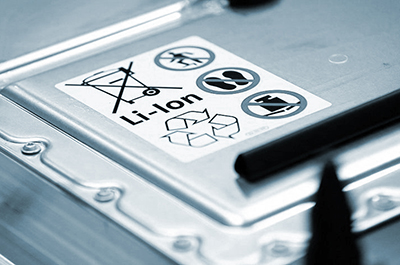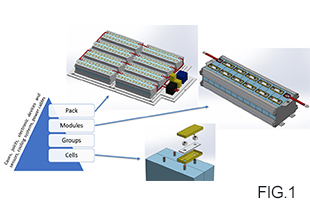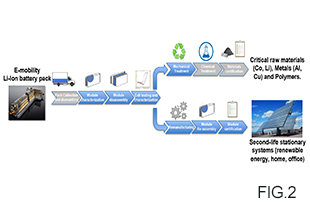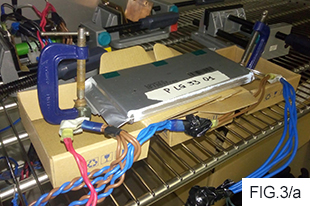
The inter-departmental Laboratory CIRC-eV “Fabbrica Circolare per i Veicoli Elettrici del Futuro” raccoglie competenze dai dipartimenti di Meccanica (Coordinatore), Energia, Chimica, Ambientale, Elettronica e Gestionale per supportare l'industria manifatturiera nel recupero e riuso ad alto valore aggiunto di materiali e funzioni da componenti di veicoli ibridi ed elettrici post-uso, favorendo l'introduzione di nuovi modelli di economia circolare per una transizione sostenibile all’e-mobility.
merges competences from the Mechanical (coordinator), Energy, Chemical, Environment, Electronics and Management departments to support the manufacturing industry in the high added-value recovery and reuse of materials and functions from electric and hybrid electric vehicles, enhancing the introduction of innovative circular economy business models for a sustainable transition to e-mobility.
The automotive industry, the most important manufacturing industry in Europe providing jobs to 12 million people with a turnover of about € 780 billion Euro and a value added of 140 billion, is undergoing a fundamental transformation pervaded by the transition from traditional Internal Combustion Engine Vehicles (ICEV) to Electric (EV) and Hybrid (HEV) vehicles. In 2020, the number of hybrid electric vehicles sold in Italy more than tripled with respect to the year before. Sells of full electric vehicles have been four times the ones of 2019 [source: UNRAE]. It is also predicted that from 2040, the number of electric and hybrid vehicles sold will be higher than internal combustion ones.
This revolution is accompanied by a fundamental transformation in the car design, featuring a substantial evolution in the critical car components and materials. For example, Lithium-Ion Battery (LiB – Lithium Ion Batteries) packs constitute one the most important car components, making up 35%-50% of the cost of the EVs. Moreover, mechatronics, smart electronics and sensors are predominant components in EVs and HEVs. Furthermore, composite materials and techno-polymers are expected to find more and more massive application in EVs and HEVs with the objective to mitigate the car weight increase caused by batteries and electronics, without compromising in safety and mechanical performance.
Opportunities and challenges: the CIRC-eV mission
The substantial change in product design brings at the same time a challenge for post-use product treatment and a huge opportunity for new circular economy-oriented businesses, affecting the entire automotive value-chain. Current waste management practices in automotive are dominated by recycling and only a small fraction of components is remanufactured and re-used as spares in the aftermarket, namely control units and mechatronic components. The market is regulated by the ELV (End-of-Life Vehicles) legislation EC Directive [2000/53/EC] fixing targets for re-use and material recovery. Although these targets are met in most of the European member states, the ongoing transition to EVs and HEVs and the related new product design may seriously undermine the achievement of these targets in the future. Currently, the lack of a sustainable post-use treatment routes for EVs and HEVs critical components constitutes a serious barrier to e-mobility and a new disruptive circular strategy needs to be designed and demonstrated.
The mission of the CIRC-eV Laboratory is to develop a new concept of Circular Factory to support the manufacturing industry in the recovery and reuse of functions and value from post-use Hybrid and Electric Vehicles, boosting the introduction of new circular economy models for sustainable e-mobility.
Products and technological challenges
The CIRC-eV will be the first European Lab dedicated to the concept of Circular Factory, integrating disassembly, testing, reassembly and material recycling functions in the same facility, to design and demonstrate new sustainable circular economy solutions for the e-mobility sector. CIRC-eV will integrate the key enabling technologies to implement these functions, focusing, in its first configuration, on the most critical component for sustainable e-mobility, namely Li-Ion Batteries.
The battery pack is the most important component of a hybrid (HEV) or full electric vehicle (EV), since it has to guarantee the power and capacity needed by the electric motors. For both HEVs and EVs, the battery pack is the most impacting component on the whole bill of material costs. There is general agreement, both in the scientific and industrial communities, to consider the lithium ion (Li-Ion) battery technology as the state-of-the-art best application for current production as well as for short and middle term future applications in the mobility sector. For its mix of high energy density, high efficiency, long lifespan and reliability, Li-Ion batteries will be the dominant power source technology in electric mobility for at least the next 10 years. Regardless its dimension, a Li-Ion battery cell has a nominal voltage of 3.6 V – 3.8 V. For this reason, the final voltage of the pack, which for EVs is almost always greater than 300 V, has to be achieved by the series assembly of cell strings. Moreover, many of the commercial Li-Ion cells can’t provide the energy capacity to achieve the needed final autonomy, for this reason, very often, at the lowest hierarchical level cells are connected in parallel strings to increase the capacity.
A fundamental peculiarity if lithium-ion cells is their electrochemical degradation curve, which is unbalanced and unique for each cell and, after a lifecycle which can vary from eight to ten years, returns a battery pack whose cells are characterized by a unique state-of-health (SOH), different for each one.
The most interesting strategy for automotive LiBs is related to the remanufacturing and re-use of the disassembled cells with proper residual characteristics into second-life stationary applications exploiting a cross-sectorial approach, for example dedicated to the storage in renewable energy installations or within living environments (home, office). On the contrary, those battery cells that do not maintain sufficient post-use properties suitable to a second-life application are sent to recycling with the objective to recover high-value materials for re-use. The development of the key enabling technologies and decision support systems to combine both strategies will make it possible to achieve a sustainable strategy for post-use management of automotive Li-Ion batteries, thus unlocking a circular business for electric vehicles.
CIRC-eV: objectives, research focus
The specific goal of CIRC-eV is to demonstrate the technical and economic feasibility of the circular process chain presented in Figure 2 (CIRC-eV circular process-chain for Li-Ion Batteries. The functional steps in blue are integrated in the CIRC-eV Lab): battery modules undergo a first characterization phase. Then single cells are disassembled exploiting an automated, selective, non-destructive and intelligent process. The residual electric properties of each cell are estimated through innovative technologies (EIS - Electrochemical Impedance Spectroscopy). Cells without residual properties suitable for reuse are mechanically pre-treated to release and sort the target materials. This facilitates and increases the efficiency of the downstream hydrometallurgical recycling process. Cells with appropriate residual properties are reassembled in second-life battery modules.
The macro technical challenges of the CIRC-eV Lab are related to:
- Design and development of a safe and cost-effective battery cells disassembly process and system, with the required level of flexibility, enabling to handle a large variety of battery designs.
- Definition of methods and procedures to estimate the State of Health (SoH) and characterize the degradation modes and the residual useful life of battery cells to enable their application in second-life modules with certified performance.
- Development of knowledge-based and data-driven decision support systems to select and configure second-life battery modules and their Battery Management System (BMS) depending on the specific second-use requirements and the post-use conditions of re-usable cells.
- Design and development of a selective mechanical pre-treatment to gather and separate the black mass, with the objective to support the recycling of key materials through downstream chemical treatments.
The CIRC-eV pilot plant will support multi-disciplinary research and innovation activities targeted to these technical challenges with high technology transfer potentials to the industry and the society as a whole.
The Mechanical department is leader of the initiative, coordinated by Prof. Marcello Colledani, and will host CIRC-eV in the B23 building. The research team also includes the competences of the Energy Department, the Department of Civil and Environmental Engineering, the Dipartimento di Elettronica, Informazione e Bioingegneria, the Department of Chemistry, Materials and Chemical Engineering "Giulio Natta" and the Department of Management, Economics and Industrial Engineering.




